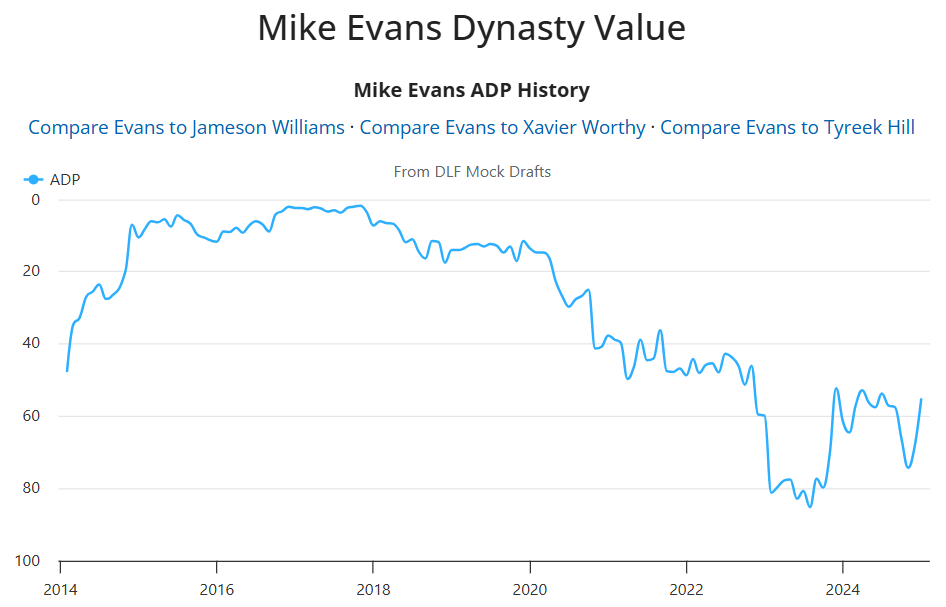If you have read my work before, you know I write in the form of “accounting memos” and apply accounting and finance themes to dynasty fantasy football. For anyone who has not been exposed, the format is very standard. Each memo will start with the “purpose.” Next, it will supply background and then outline the applicable “guidance,” or accounting literature utilized. Last will be the analysis and conclusion. The goal is to state the issue and quickly address it. My write-ups will follow this same logic. To summarize, welcome to “Good at Analyzing Players” or “GAAP”, a play on “Generally Accepted Accounting Principles” (and yes, my wife did come up with it).
Purpose
The purpose of this memo is to evaluate the value of second-year running back breakouts in dynasty fantasy football, using the concept of an “investment maturity date” to assess their long-term potential and the optimal time for payoff.
Background
In both finance and dynasty fantasy football, every investment has a “maturity date”—a point at which the asset has fully developed, reached its peak value, and can yield the greatest return. For elite fantasy football assets, the journey to maturity is often linear. Meaning, that as soon as the rookie hits the NFL gridiron, they produce and amass value immediately. Those are the Justin Jeffersons and Ja’Marr Chases of the dynasty world. For every handful of those, there is a Nico Collins who takes a nonlinear trajectory with prolonged valleys in their value on the way to superstardom. With valleys on the way to maturity, there is value to be gained in dynasty.
In the context of dynasty, this concept is particularly interesting for young players and seems to impact positions differently. Some player’s maturity date is the date that they are drafted (i.e., peak value). Most recently, this would be a player like Treylon Burks, who was drafted and immediately in the dog house for conditioning at training camp and never materialized into an every-down NFL player (let alone fantasy-viable).
Elite quarterbacks and wide receivers can accumulate value right away and their maturity date is usually two to three years into their careers after proven success. From that point on, the player usually depreciates. Two examples of this theory are Mike Evans and Brock Purdy. See their ADPs over time below:
Above, Mike Evans maturity date to maximize value was in 2017; his third NFL season. However, his value spiked materially after his rookie season.
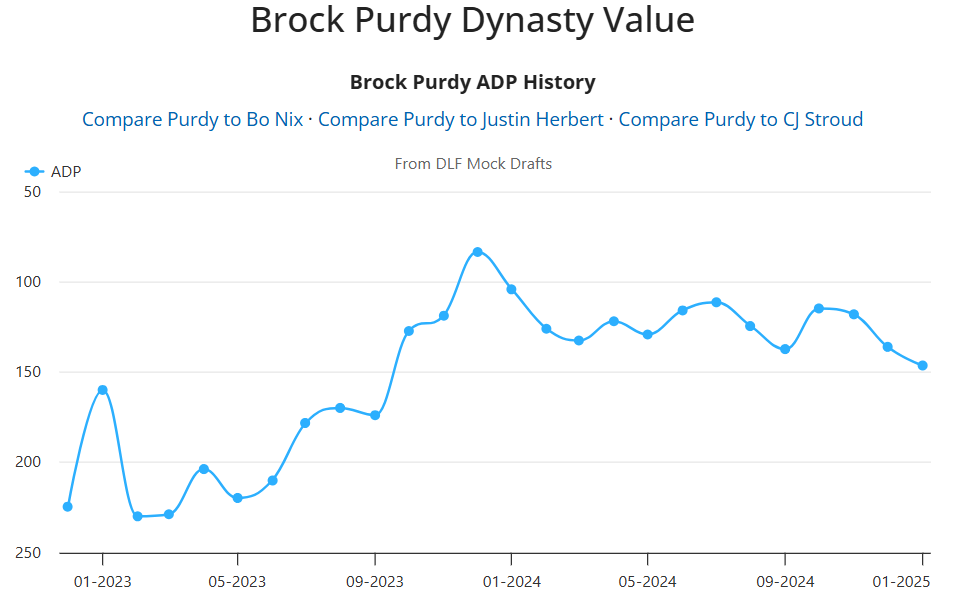
While a much more condensed time frame, the graph depicts that Purdy’s maturity date (to date) was January 2024 after his Super Bowl appearance as a rookie.
The premise is that WRs and QBs who have elite upside often break out early (if they are going to) and accumulate value very quickly.
Comparably, there has been a trend of running backs increasingly depreciating after their rookie seasons – meaning that the position might have a different maturity pattern than WR and QB. Recent great examples of this include: James Cook (RB9 on DLF), Chase Brown (RB11 on DLF), Kyren Williams (RB7 on DLF), and Tank Bigsby (RB30 on DLF). See their ADP charts below:
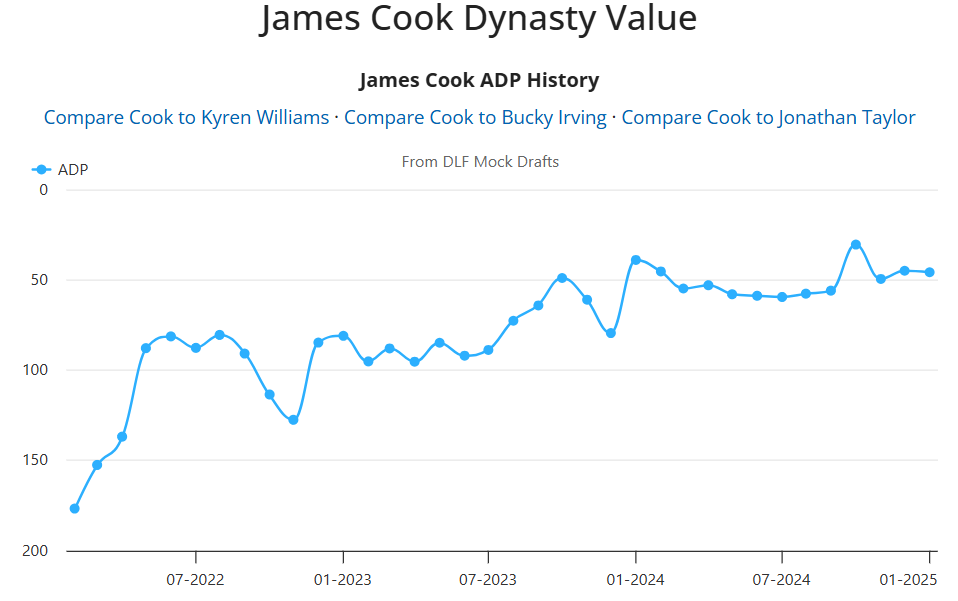
*Note decline in November 2022 (rookie season)
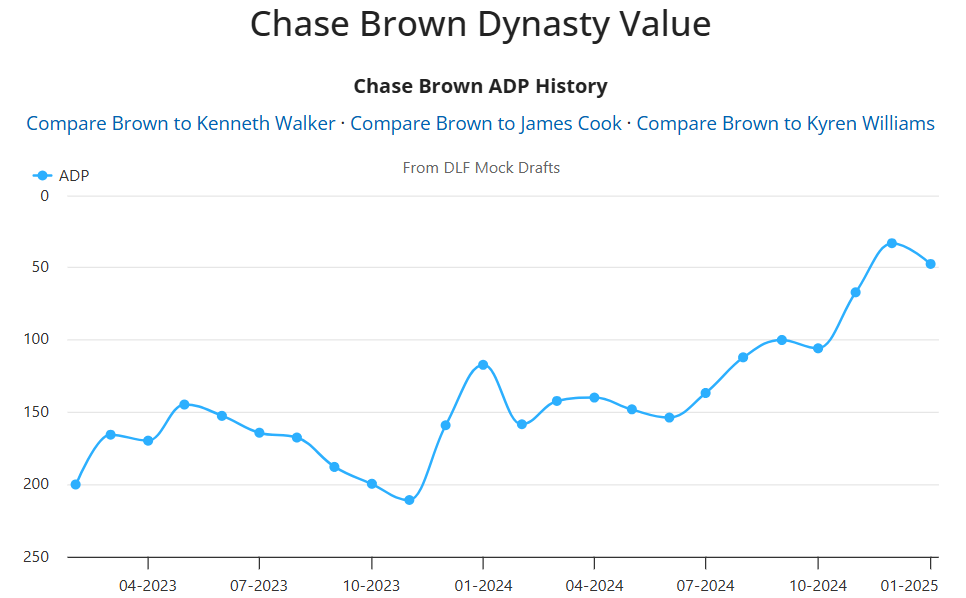
*Note decline in November 2023 (rookie season)
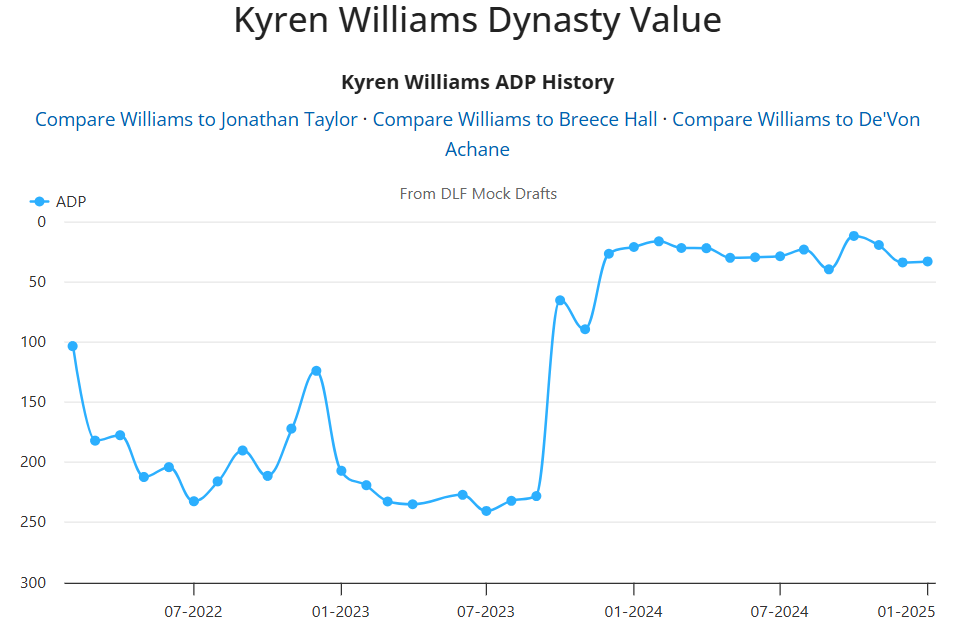
*Note decline throughout 2022 (rookie season)
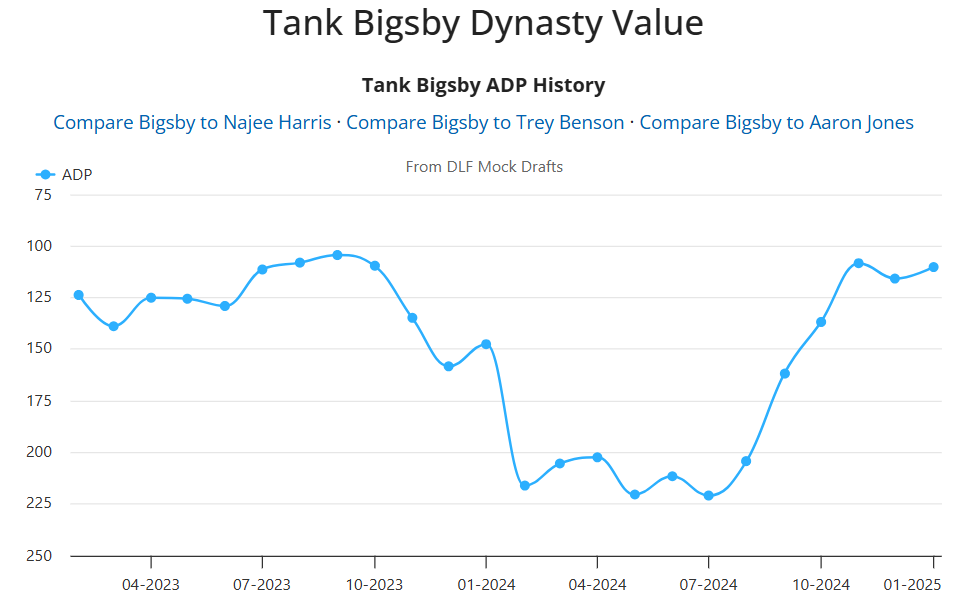
*Note decline in July 2024 (after rookie season)
These deferred breakouts have certainly become common in the fantasy football world amongst the running back position. This memo will explore the 2024 rookie running backs to examine, which might present a buying opportunity on their way to maturity (i.e., max dynasty value) utilizing the “RB Maturity Approach”.
Resources:
- Sleeper: Great interface for looking up historical statistics
- DLF Dynasty Rankings: Best dynasty rankings in the industry
- DLF Average Draft Position (“ADP”) Data: Best resource to gauge current player value. Based on real dynasty startups.
- Investopedia: World’s leading source of financial content on the web.
Analysis
To begin this analysis, I will exclude the RBs who have already potentially reached maturity (or their peak value). These RBs include Bucky Irving and Tyrone Tracy. I will also exclude Jonathon Brooks due to the injury bug, but he might be on the Treylon Burks trajectory after back-to-back ACL tears.
Here are the other candidates with analysis and potential maturity dates:
Trey Benson, ARI
Benson was drafted at 3.02 in the 2024 NFL Draft, which is great draft capital for the position in today’s NFL. At 216 lbs and 6’0”, Benson also has prototypical size to go along with a 98th percentile speed score. However, he only amassed a 17.3% snap share during his rookie season. This lack of usage led fantasy managers to lose confidence in the former Florida State Seminole.
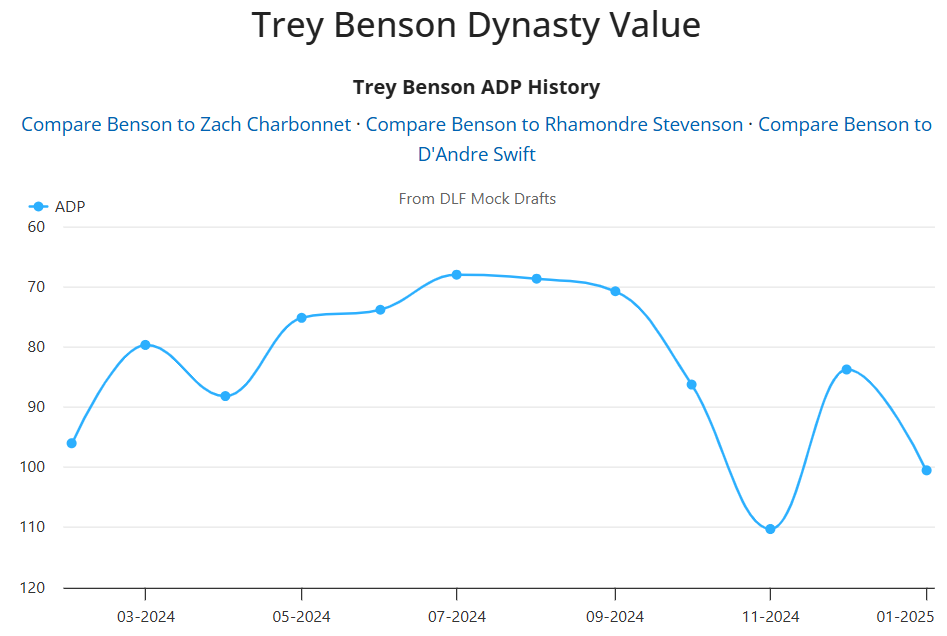
With third-round draft capital, why couldn’t the rookie get on the field? Elderstatesmen James Conner was holding down the RB1 position. However, at almost 30, Conner had 282 touches in 2024. That’s a lot of miles on a 30-year-old body not named Derrick Henry. While in December 2024, the Cardinals did extend Conner for two more years, the contract details have an out after 2025.
I think the plan is to move from Conner to Benson during the 2025 season. There is certainly enough volume for both players to get touches as the Cardinals ran the ball over 27 times during the 2024 season. If Benson gets increased volume and continues with his 4.6 yards per carry from 2024, wheels up on his dynasty value. That could propel him to be a RB2 as early as 2025 and likely a RB1 candidate in 2026 and 2027.
I would move off more proven players like Tony Pollard or D’Andre Swift for that kind of upside and could likely get something on top.
Estimated Maturity Date: After the 2025 season
Ray Davis, BUF
Davis is an older RB at 25 entering his sophomore season after being selected at 4.28 in the 2024 NFL Draft. At 5’8” and 211, he profiled as the thunder to James Cook’s lightning. The issue in 2024 was that Cook was a one-man storm and amassed 18 total TDs last season. However, when given the opportunity, Davis flashed talent and fantasy managers took notice. His ADP actually climbed throughout his rookie season; see below:
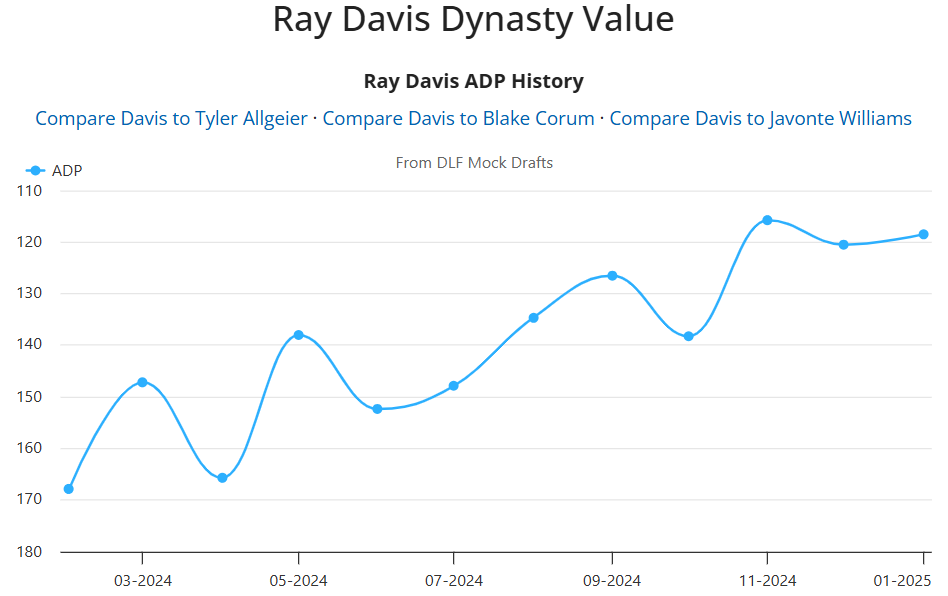
I’m actually a fan of his game from what I have seen. However, his deep analytics compared to James Cook are not close. For instance, Ray Davis has 3.9 yards per carry with only a 3.5% breakaway run rate while Cook averaged 4.9 yards per carry and a 4.8% breakaway run rate. Not to mention that Cook is the better receiving back of the two, which amounts to fantasy gold. With that in mind, I would not be surprised if the Bills go back to the well in the deep 2025 RB draft class before they promote Davis to RB1.
Given this, if a league mate is projecting a Ray Davis breakout, I would gladly sell at today’s market.
Estimated Maturity Date: Today / Already Happened (i.e., Sell)
Blake Corum, LAR
A lot of people projected that Corum would supplant Kyren Williams during the 2025 season after he was selected at 3.19 in the 2024 NFL draft. At 5’8” and 205 lbs, he has more prototypical size than Williams, draft capital, and a much more accomplished collegiate career at Michigan. While I was not a believer of that narrative last summer, his ADP below clearly depicts that there was some optimism.
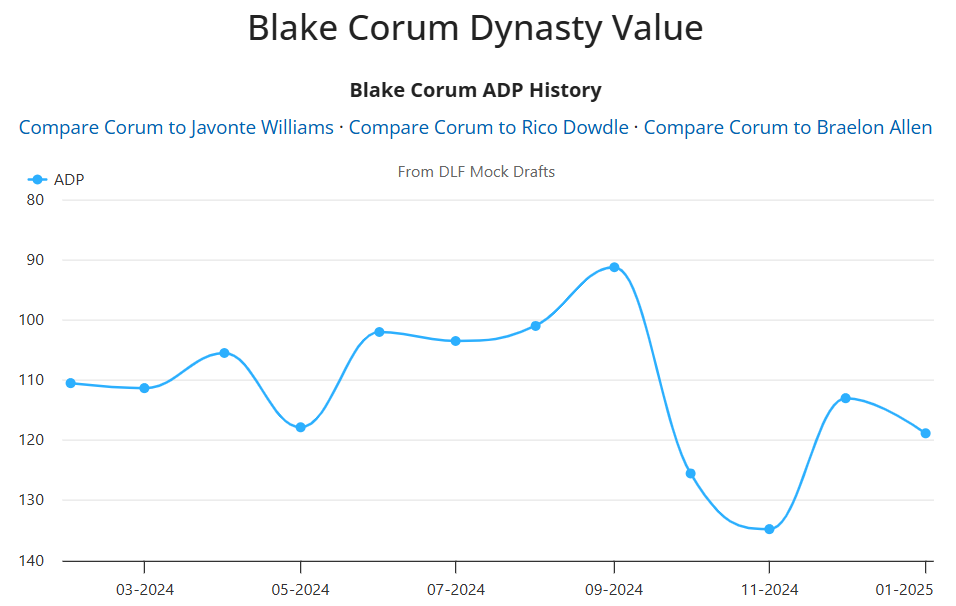
That optimism was certainly debunked as soon as football started and Corum’s dynasty value started to fall. This was fueled by Kyren Williams barely coming off the field throughout the season as he was on the field 80% to 90% of the time for the Rams. That’s where I think this gets interesting and I think history all too often has a history of repeating itself. If we rewind to William’s rookie season in 2022, he had a 27.2% snap share. While Corum’s snapshare during his rookie season was only 10.5%, he was competing against Williams, who just came off a 1,300+ yard season with 15 TDs. Kyren Williams during his rookie tenure was competing against Cam Akers post knee injury and Darrell Henderson. Not quite the same. Additionally, William’s contract is up after 2025 and I’m not sure he commands RB1 money in free agency (especially after the 2025 rookie class).
I expect Corum to take a step in 2025 and get a chance to assume the RB1 role in 2026. However, I will likely wait to see if the Rams revisit the position in the 2025 draft with an early pick. If not, I’ll be sending thirds for Corum during rookie drafts.
Estimated Maturity Date: Flash in 2025; Maturity in 2026
MarShawn Lloyd, GB
Lloyd was drafted at 3.25 in the 2024 draft. At 5’9” and 220, he has elite speed with a 93rd percentile speed score. The Packers clearly thought Lloyd could be the 1b to their newly signed 1a in Josh Jacobs, who they had signed in free agency last summer. That plan got off to a bad start when Lloyd picked up a Hamstring strain during the preseason, then an ankle sprain in week two, and finally appendicitis in week 11. This led fantasy managers to become frustrated and his ADP fell as a result.
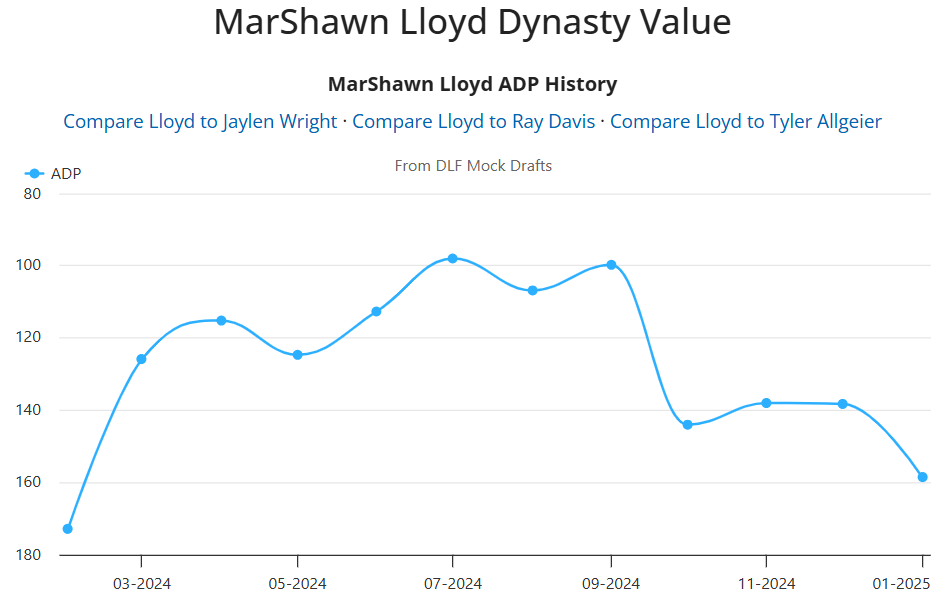
This lack of depth at the position allowed Josh Jacobs to erupt to the tune of 1,300 yards and 15 TDs. This was the most by a Packers RB since Ahman Green in 2003 (1,883) and the most by far of any RB under Matt LaFleur’s tenure as the Packers head coach. Since he was hired in 2019, the team’s leading rusher had an average of 213 carries. Josh Jacob’s had 301 in 2024. I would expect for Jacobs to continue to be the 1a, but there could be 100+ carries for Lloyd if he can stay healthy. I would bet on some regression to the mean there.
The issue becomes that Josh Jacobs has three years remaining on his deal and is still only 27. He is another one I’ll be trying to buy cheap during the 2025 rookie drafts if the Packers don’t spend high draft capital on another RB.
Estimated Maturity Date: Flex-Worthy in 2025
Others
There are a handful of other backs to be considered with this premise. However, each of them has a star RB in front of them with high draft capital. These include Jaylen Wright (De’Von Achane), Braelon Allen (Breece Hall), Keaton Mitchell (Derrick Henry), and Audric Estime (Sean Payton’s “Joker” from the 2025 class that he can not stop talking about).
Conclusion
As a fantasy manager, we are always looking for “the next Player A”. The issue with that is that we are often going to be disappointed. We should be looking for similar profiles and market trends and try to capitalize as best we can (i.e., shoot your shot). There is clearly a pattern surrounding the maturity rate of RBs and, if you pick the right guy, you could capitalize and get a discounted RB1/RB2 for pennies on the dollar. With RBs, the game is often a volume play and given that history, the “RB Maturity Approach” is a cost-effective way to identify upside.
The good news with this premise is that all the 2025 rookies will not hit year 1 and there will likely be another batch next year to try again.
“To make mistakes is human; to stumble is commonplace; to be able to laugh at yourself is maturity.”
Source link
Read More
Visit Our Site
Read our previous article: ‘I’m sorry’ – Kevin Garnett unleashed ruthless Michael Jordan on his own teammate and paid ultimate price
Sports Update: The premise is that wrs and qbs who have elite upside often break out early (if they are going to) and accumulate value very quickly Stay tuned for more updates on Dynasty GAAP Memo: Running Back Maturity Approach And Second-Year RBs and other trending sports news!
Your Thoughts Matter! What’s your opinion on Dynasty GAAP Memo: Running Back Maturity Approach And Second-Year RBs? Share your thoughts in the comments below and join the discussion!
